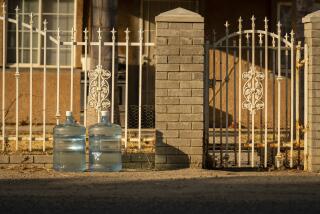How Salt Water Might Some Day Help Slake Our Thirst : Desalination plants: no panacea but a promising water option
Even in a severe drought, most of California has too much natural water to start building desalination plants on a grand scale. But there are exceptions, like Catalina Island, Santa Barbara and perhaps even Monterey, where producing drinking water by taking the salt out of sea water makes economic sense right now.
And research to improve desalination technology still makes sense, against the chance that all else will somehow fail.
For the record:
12:00 a.m. March 2, 1991 For the Record
Los Angeles Times Saturday March 2, 1991 Home Edition Metro Part B Page 5 Column 5 Letters Desk 1 inches; 30 words Type of Material: Correction
A Feb. 25 editorial incorrectly estimated the cost of desalinated water as 3 cents a gallon. The cost would be 0.3 cents, making the daily cost of water for the average Southern California user something under $1.
Gov. Pete Wilson had it right recently when he said desalination plants work best in desert regions where everybody understands that it is not going to rain for decades--maybe ever. Californians can never be sure when a wet spell will reduce the incentive to appropriate $2 billion for a desalination plant.
Still, it is useful in the fifth year of waiting for heavy rain to examine the way that 1990s desalination would affect family budgets. The costs are stratospheric but not catastrophic.
According to the state Department of Water Resources, the average per capita consumption of water in urban areas when the supply is plentiful is between 200 and 300 gallons a day.
The least expensive desalinated water that specialists think can be produced along the California coast today would cost about $1,000 an acre-foot (an acre-foot is a standard measure for large volumes of water and one that would supply two average California households for a year).
That breaks down to about 3 cents a gallon and, at 200 gallons a day, to $6 a day for showers, lawns, gardens, dish washing and drinking. That’s about four times the going cost of water in Southern California today.
In a desalinated economy, recycled water would be used for watering lawns and washing cars and possibly for washing clothes, so the total cost would drop some. Leon Awerbuch, head of desalination for the San Francisco-based Bechtel Corp., who has built plants all through the Middle East, notes that blending desalinated water with water of lower quality would bring the cost down even further.
Bechtel is studying the feasibility of a combined power and desalination plant in the Tijuana area that would produce 100 million gallons of water a day. Interested parties include the Metropolitan Water District, the Los Angeles Department of Water and Power and Southern California Edison.
For now, state water authorities say they stand by their last formal evaluation of desalination in 1987, which concluded that for most uses the technology is “still too expensive for all but a few situations and places in California.”
There is also the question of where desalination plants would go. Desalination costs less if the water processor is combined with a power plant whose steam would be cooled and captured as pure water after it had passed through the generating turbines.
A plant Bechtel is building in Dubai on the Persian Gulf will cover 100 acres of coastal property. Most places between Long Beach and San Diego in Southern California would want to think twice about a project that big, except when all else has failed.
The most sensible way for California to get by for the moment is to reallocate the 28 million acre-feet of water that is still available, despite the drought, for delivery to cities and farms.
The governor’s emergency water plan does that in two ways. Sacramento will broker water among farmers who have more than they can use and farmers or cities in desperate need.
It also is creating a “water bank” that will reimburse farmers, who pay as little as $30 per acre-foot for their water, to take land used for water-intensive crops out of production and free up the water for sale elsewhere. That would cost far less than desalination.
Nevertheless, desalination needs to be an option in our long-term water future. The vicissitudes of the weather, of the overall supply and of further demand for water make the case for not ignoring a technology that is still not fully explored and whose costs may decrease over time as the technology improves.
COMPARATIVE WATER COSTS
Los Angeles aqueduct Approximate price per 100 gallons: 3 cents San Fernando Valley ground water Approximate price per 100 gallons: 4 cents Metropolitan Water District water Approximate price per 100 gallons: 7 cents Reclaimed water Approximate price per 100 gallons: 10 cents Desalinated water (Santa Barbara) Approximate price per 100 gallons: 58 cents 5-gallon bottled water Approximate price per 100 gallons: 152 dollars Perrier Approximate price per 100 gallons: 651 dollars
More to Read
Sign up for Essential California
The most important California stories and recommendations in your inbox every morning.
You may occasionally receive promotional content from the Los Angeles Times.










